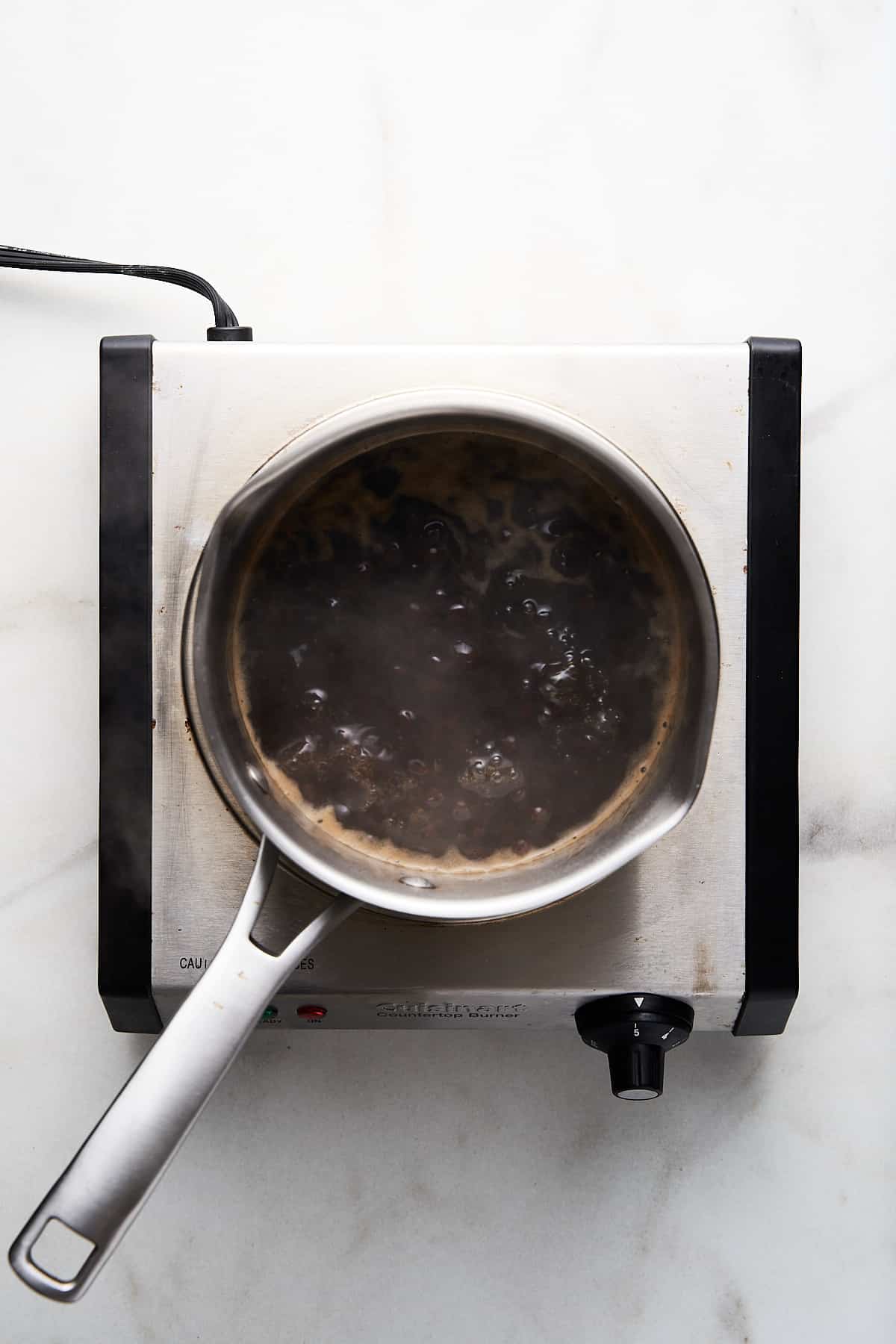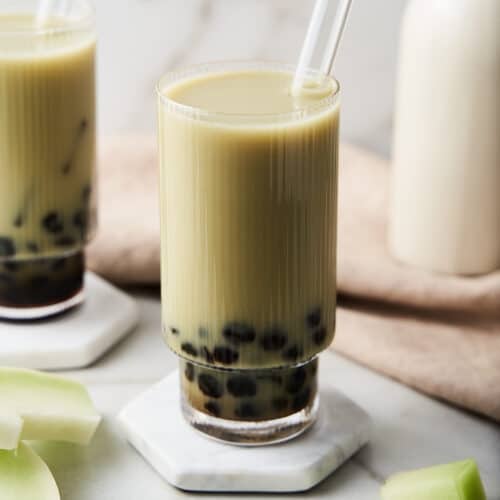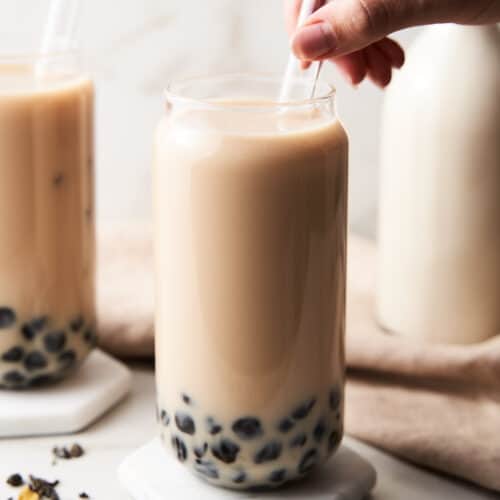Thai Tea Boba
Thai tea boba is an ice-cold, creamy bubble tea filled with authentic spices like anise, cardamom, and cinnamon. Try recreating this delicious tea beverage from the comfort of your own home at a fraction of the price as store-bought options!

This Thai tea boba recipe is the perfect example of how easy it is to recreate bubble tea shop-quality drinks at home. It’s vibrant, aromatic, and easy to customize. For another unique and exotic milk tea flavor, give my taro milk tea a try!
Why I love this recipe
Thai tea boba is usually made up of black tea, condensed milk, evaporated milk, and tapioca pearls, but I like to keep things dairy-free around here. I use coconut milk to make it equally as rich and creamy with tropical undertones.
Paired with turmeric for that characteristic Thai tea orange hue, a few whole spices, and cane sugar, it’s inexpensive yet flavor-packed. If your bubble tea shop budget is getting out of hand, this homemade recipe is a must-try!
Also known as “Cha Yen” in Thailand, this cold tea is the ideal way to cool off on a hot summer day. Each sip has the perfect balance of sweet, creamy, and subtly spiced flavors I can never get enough of!
Ingredient notes
No expensive or difficult-to-find ingredients are required for this Thai tea boba. Find a full breakdown and suitable substitutes below!

Black tea
I use loose-leaf Assam tea, but you can use Darjeeling, Ceylon, English Breakfast, Earl Grey, or any strong black tea bags you have on hand. Don’t let it steep past 5 minutes to prevent bitter flavors.
Coconut milk
For Thai bubble tea, I prefer the full-bodied consistency and tropical flavor of coconut milk. Use full-fat coconut milk from a can for the best results.
Substitute: For a lighter flavor and mouthfeel, use soy, almond, or oat milk.
Spices
I use whole cinnamon sticks, green cardamom pods, and star anise for flavor. The turmeric provides a signature Thai milk tea color without artificial ingredients.
Tapioca pearls
Uncooked tapioca pearls, also known as boba, are readily available at Asian food markets or online. If you are short on time, use quick-cooking boba. However, if you are up to it, making boba from scratch is always worth the effort.
Sugar
I use unrefined cane sugar to sweeten the boba and tea while keeping the price down.
Substitute: If you don’t have cane sugar, use another sweetener like agave, brown rice syrup, or beet sugar.
For a complete ingredient list and step-by-step guide, scroll down to our recipe card.
How to make
Learn the best way to make Thai tea boba with my straightforward, easy-to-follow instructions. Look for the tips in green throughout this section for consistent and successful results!
Cooking
Step 1
Bring the water for the tapioca pearls to a boil in a medium-large saucepan. Once boiling, add the pearls and lower the heat to just under medium for 15-30 minutes.
Stir the pearls every 5 minutes to prevent them from sticking to each other or the bottom of the pan. The cooking time can vary, so refer to your package for specific instructions.

Step 2
While the boba cooks, combine ⅓ cup of cane sugar with ⅓ cup of water in a small saucepan. Heat the mixture until the sugar dissolves to create a simple syrup. Remove the saucepan from the heat and reserve a few tablespoons, then add the rest to a medium mixing bowl.

Step 3
Strain the tapioca pearls through a fine-mesh strainer, rinsing them gently. Transfer the pearls to the mixing bowl with the syrup and stir to combine. Set aside to soak while you make the Thai tea.
Soaking the boba in syrup not only sweetens them but also helps keep them from sticking together.

Step 4
In another pot, combine water, black tea leaves, star anise, cardamom, cinnamon, and turmeric. Simmer the mixture for 5 minutes to infuse the tea and spices.
Adjust the steeping time based on how strong you prefer your tea. Start tasting it at 3 minutes to find your perfect brew strength.

Step 5
Strain the tea into a pitcher and stir in the remaining simple syrup. Let it cool to room temperature before assembling your bubble tea.

Step 6
To serve, add 3-4 tablespoons of tapioca pearls to a glass, fill it halfway with ice, pour the Thai tea to the halfway point, and top it with coconut milk. Taste and adjust the sweetness to your liking. Happy drinking!

Expert tip
The Thai tea blend is important to get right since it’s the primary flavor component. Use fresh or properly stored spices for the most rich, aromatic taste.
Keep a close eye on the tea mixture as it simmers to prevent over-brewing your tea. Oversteeping can result in bitterness, which will overpower the delicate spices and sweetness of the drink.
Another often overlooked element is the quality and preparation of your tapioca pearls. If possible, opt for uncooked tapioca pearls, not quick-cooking boba.
They should be cooked until they are tender and chewy but not mushy, so start taste-testing them early on in the boiling process for the perfect texture.
Cooking tips
Consume right away: Don’t wait to drink your Thai tea boba! The tapioca pearls start to degrade and become hard the longer they sit, so it’s best enjoyed immediately.
Use the right straw: Thai bubble tea should be consumed through a wide-mouth straw made specifically for bubble tea. While plastic or stainless steel straws are available, I love glass boba straws.
Water temperature: Boil the water for your tea just until it bubbles. Overheated water can make black tea bitter and overshadow the delicate spice flavors.
Syrup sweetness: Adjust the sweetness of your drink according to your preferences. Start with less simple syrup, as you can always add more but can’t take it away!
Frequently asked questions
Yes, but the flavor won’t be as robust. Use high-quality black tea bags to get closer to the authentic taste.
Yes, Thai tea boba contains caffeine since it’s made with black tea. You can make a caffeine-free version with decaf black tea or rooibos.
They might need more time. Cooking times can vary, so continue simmering and testing one every few minutes until they reach a soft, chewy texture.
More teas & lattes
Hungry for more?
If you enjoyed this recipe, please consider leaving a star rating and a comment down below! Your feedback not only helps others discover our blog but also gives us valuable insights from your experience.
Don’t forget to subscribe to our newsletter for the latest recipes, and check out our shop for our top kitchen recommendations. Thank you for supporting BBV!
Recipe

Creamy Thai Tea Boba (9 Ingredients)
Equipment
- Teapot
- Medium saucepan
- Small saucepan
- Mixing bowl
- Boba straw
Ingredients
Boba
- ½ cup uncooked black tapioca pearls
- 6 cups water
- ⅓ cup cane sugar + ⅓ cup water
Thai tea
- 4 cups filtered water
- 1 tablespoon loose-leaf black tea
- 2 whole star anise pods
- 2 whole green cardamom pods, lightly crushed
- 1 inch cinnamon stick
- ¼ teaspoon turmeric
- ½ – ¾ cup full-fat coconut milk
- 3-4 tablespoons extra simple syrup
- Ice to serve
Instructions
Boba
- Bring the water for the tapioca pearls to boil in a medium-large saucepan. Once boiling, add the pearls and lower the heat to just under medium.
- Simmer for 15-30 minutes, stirring every 5 minutes to prevent sticking. Cooking time will depend on your specific pearls (check the package for instructions — mine take 30 minutes).
- In the meantime, prepare the simple syrup. Add cane sugar and water to a small saucepan and whisk together. Bring to a simmer for about 3-5 minutes until the sugar dissolves. Remove from heat, reserve 3-4 tablespoons, then add the rest to a medium mixing bowl.
- Strain the tapioca pearls through a fine-mesh strainer, rinsing them gently. Transfer the pearls to the mixing bowl with the simple syrup and stir to combine. Set aside for 30 minutes to soak.
Thai tea
- While the tapioca pearls are soaking, add water, black tea leaves, star anise, cardamom, cinnamon, and turmeric to a medium saucepan. Bring the mixture to a simmer for 5 minutes.
- Once steeped, strain the Thai tea into a heat-safe container or pitcher. Add simple syrup and stir to combine.
Assembly
- Let the tea cool to room temperature. Add 3-4 tablespoons of tapioca pearls to a glass, folllowed by a handful of ice. Pour the Thai tea ½ – ¾ of the way up, then coconut milk the rest of the way. Happy drinking!
Notes
Nutrition
Note: I’ve updated this post to include new information and helpful tips about the recipe.
Justine Drosdovech is a food writer, photographer, and one of the founders of Broke Bank Vegan. She is a self-taught plant-based chef but uses her healthcare background to craft dishes that are both delicious and nourishing.




